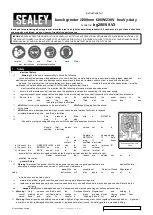
8
English
Follow the fitting instructions supplied with good quality plugs.
Recommended fuse: 3 A.
Using an Extension Cable
An extension cord should not be used unless absolutely
necessary. Use an approved extension cable suitable for
the power input of your charger (see
Technical Data
). The
minimum conductor size is 1 mm
2
; the maximum length
is 30 m.
When using a cable reel, always unwind the cable completely.
Important Safety Instructions for All Battery
Chargers
SAVE THESE INSTRUCTIONS:
This manual contains important
safety and operating instructions for compatible battery
chargers (refer to
Technical Data
).
• Before using charger, read all instructions and cautionary
markings on charger, battery pack, and product using
battery pack.
WARNING:
Shock hazard. Do not allow any liquid to get
inside charger. Electric shock may result.
WARNING:
We recommend the use of a residual current
device with a residual current rating of 30mA or less.
CAUTION:
Burn hazard. To reduce the risk of injury,
charge only
D
e
WALT
rechargeable batteries. Other types of
batteries may burst causing personal injury and damage.
CAUTION:
Children should be supervised to ensure that
they do not play with the appliance.
NOTICE:
Under certain conditions, with the charger
plugged into the power supply, the exposed charging
contacts inside the charger can be shorted by foreign
material. Foreign materials of a conductive nature such
as, but not limited to, steel wool, aluminum foil or any
buildup of metallic particles should be kept away from
charger cavities. Always unplug the charger from the
power supply when there is no battery pack in the cavity.
Unplug charger before attempting to clean
•
DO NOT attempt to charge the battery pack with any
chargers other than the ones in this manual.
The charger
and battery pack are specifically designed to work together.
•
These chargers are not intended for any uses other than
charging
D
e
WALT
rechargeable batteries.
Any other uses
may result in risk of fire, electric shock or electrocution.
•
Do not expose charger to rain or snow.
•
Pull by plug rather than cord when disconnecting
charger.
This will reduce risk of damage to electric plug
and cord.
•
Make sure that cord is located so that it will not be
stepped on, tripped over, or otherwise subjected to
damage or stress.
•
Do not use an extension cord unless it is absolutely
necessary.
Use of improper extension cord could result in risk
of fire,electric shock, or electrocution.
•
Do not place any object on top of charger or place
the charger on a soft surface that might block the
ventilation slots and result in excessive internal heat.
Place the charger in a position away from any heat source. The
charger is ventilated through slots in the top and the bottom
of the housing.
•
Do not operate charger with damaged cord or plug—
have them replaced immediately.
•
Do not operate charger if it has received a sharp blow,
been dropped, or otherwise damaged in any way.
Take it
to an authorised service centre.
•
Do not disassemble charger; take it to an authorised
service centre when service or repair is required.
Incorrect
reassembly may result in a risk of electric shock, electrocution
or fire.
• In case of damaged power supply cord the supply cord must
be replaced immediately by the manufacturer, its service agent
or similar qualified person to prevent any hazard.
•
Disconnect the charger from the outlet before
attempting any cleaning. This will reduce the risk of
electric shock.
Removing the battery pack will not reduce
this risk.
•
NEVER
attempt to connect two chargers together.
•
The charger is designed to operate on standard
230V household electrical power. Do not attempt to
use it on any other voltage.
This does not apply to the
vehicular charger.
Charging a Battery (Fig. B)
1. Plug the charger into an appropriate outlet before inserting
battery pack.
2. Insert the battery pack
10
into the charger, making sure the
battery pack is fully seated in the charger. The red (charging)
light will blink repeatedly indicating that the charging
process has started.
3. The completion of charge will be indicated by the red
light remaining ON continuously. The battery pack is fully
charged and may be used at this time or left in the charger.
To remove the battery pack from the charger, push the
battery release button
11
on the battery pack.
nOTE:
To ensure maximum performance and life of lithium-ion
battery packs, charge the battery pack fully before first use.
Charger Operation
Refer to the indicators below for the charge status of the
battery pack.
Charge Indicators
Charging
Fully Charged
Hot/Cold Pack Delay*
*
The red light will continue to blink, but a yellow indicator light
will be illuminated during this operation. Once the battery pack
has reached an appropriate temperature, the yellow light will
turn off and the charger will resume the charging procedure.
The compatible charger(s) will not charge a faulty battery pack.
The charger will indicate faulty battery by refusing to light.
Содержание DCG405P3
Страница 1: ...DCG405 Final page size A5 148mm x 210mm ...
Страница 3: ...1 Fig A Fig B 90 90 4 5 8 11 10 3 7 2 1 10 10 11 6 9 ...
Страница 4: ...2 Fig E Fig C 5 14 13 12 9 5 Fig F 18 17 16 7 19 6 4 Fig D 15 Fig G ...
Страница 61: ...59 Türkçe KULLANMA A98 8 ødø1 ø ø 5 Matkaplar 7 yıl a Sözleşmeden dönme ...
Страница 82: ......
Страница 83: ......
Страница 84: ...503913 02 RUS US 08 19 ...











































